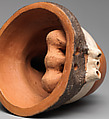Cóndor whistle
Argentinian (Anon., San Fernando del Valle de Catamarca)
Not on view
Pottery whistles have been widespread throughout South and Central America for many centuries, where working in clay enabled their makers to experiment with sophisticated sounding mechanisms such as ducts with chamfered fipples and multiple chambers and fingerholes. Their figural forms are often works of art in their own right as well as illuminating aspects of the culture of their makers. This whistle in the form of the head of a condor is a modern representation of this continuing tradition.
This whistle references the importance of the condor in traditional South American culture, where it is regarded as sacred. The condor is widely held as an emissary between the world of the living and the dead. It is said to carry prayers and guide souls to heaven. A symbol of freedom, it is the national bird of Argentina and Ecuador.
The single mouthpipe of this whistle directs air into three separate, globular chambers concealed in its base. The resulting sound is surprisingly loud and produces a tone comprised of three closely spaced pitches, perhaps in imitation of the screech of the condor.(Bradley Strauchen-Scherer, 2023)
Due to rights restrictions, this image cannot be enlarged, viewed at full screen, or downloaded.
This artwork is meant to be viewed from right to left. Scroll left to view more.






